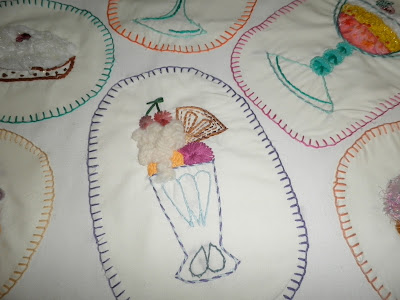Degas and the Ballet Picturing Movement is an exhibition currently focused on Degas as the painter of Dancers. Showing at the Royal Academy of Arts until 11th December. Impressionism was born in the 1870s. It was apparent there were three underlying themes in the artist’s work that include the female figure, silhouette and movement. Degas was interested in light and part of his practise involved twirling toy ballerinas by candlelight in order to study the flickering shadows. Degas studied the ballet because he was interested in movement and the way in which movement could be represented. Movement was a subject that wasn’t possible to capture through photography at the time. Whilst dancers held static positions for the camera for long periods of time, Degas’ paintings held a vivid realism. Degas tended to work from observation, memory and modern life.
 |
| Close up of Before the Ballet, Edgar Degas, 1890-92, Oil on Canvas, 40x89 cm |
 |
| Close up of The Dance Lesson, Edgar Degas, 1879, Oil on Canvas, 38x88 cm |
Ballet scenes included a blur of dancing figures and dramatic lighting. Degas’ paintings included a sense of swirl and twirling movement that cameras could not record at the time. Degas painted ballerinas in positions that sometimes couldn’t be held for more than a couple of seconds for example a ballerina on pointe suggested movement because it was impossible to sustain and an action that eluded photographers. Degas regularly painted at the opera to include light shining onto tutus. Ballet represents the human body, Degas enjoyed the pretty fabrics and rendering movements. Degas' paintings were the outcome of a systematic process he used grid lines that are still visible in some of his paintings and he painted dancers holding the same position from several angles. Degas recorded 26 figure studies from a stationary profile. Drawing was a discipline.
 |
| Close up of The Dance Lesson, Edgar Degas, 1879, Oil on Canvas, 38x88 cm |
 |
| Dancer, Study for 'L'Attente', Edgar Degas, 1882, Charcoal and pastel on laid paper, 45.7x31.1 cm |
 |
| Two Studies of a Dancer, Edgar Degas, 1878-79, Charcoal, pastel and wash on paper, 47.2x58.5cm |
Degas introduced strong black outlines to his later paintings using charcoal. Degas’ knowledge of the ballet was complex due to the large quantity of varied poses and stages of movement he recorded as an artist. Degas later drew from photographs and dabbled in creating video from photography. Some of the artist’s paintings became free and Degas even used his fingers to apply the paint and his fingerprints are visible on pieces of artwork today. The last series of paintings were created using oil pastel instead of oil paints and recorded dancers from relaxed poses. This allowed Degas to create poetic strokes of colour with zigzag pastel movement and energy came from the medium rather than the dancers moving themselves. The oil pastels allowed Degas to layer colour. Seeing this exhibition enabled me to view the different stages Degas went through as a painter of dancers and I learnt a lot about the artists beliefs, techniques and achievements as a recorder of movement.
 |
| Dancers in Blue, Edgar Degas, 1890, Oil on Canvas, 85x75.5 cm |






















































